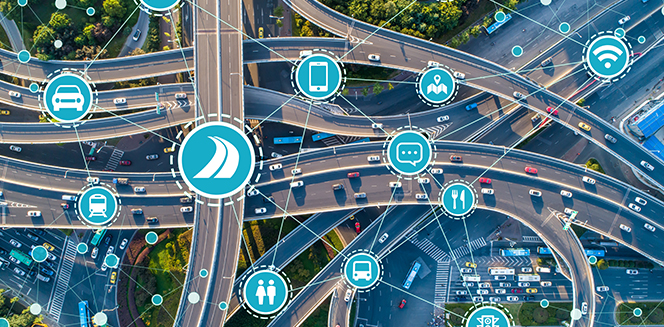Smart Transportation: A Need of the Hour

31 May
2019
A vital aspect of the modern economy, transportation accounts for a major share of the gross domestic product (GDP) in many countries. Even though transportation has enhanced our lives to a great extent, numerous issues such as traffic accident, inadequate parking spaces, congestion, lack of last mile connectivity, and vehicle emission remain unaddressed and unsolved. A smart transportation system recently became a popular topic on the Internet of Things (IoT) area and is considered as a key solution to the problems mentioned above. It can tackle all these challenges with the help of techniques that are accessible and intelligent, thereby improving safety, mobility, and efficiency. The techniques include data acquisition, data distribution, data communication, and others.
The smart transportation market experiences rapid growth in recent years. As per Allied Market Research, the global smart transportation market accrued a sum of $63.67 billion in 2015 and is likely to garner $237.70 billion through 2022, thereby growing at a CAGR of 18.6% during the forecast period, 2016 - 2022.
The growth is driven by the surge in demand for efficient transportation networks across the world, benefits offered by smart transportation systems such as ease of traffic congestion, enhancement of safety, sustainability, and efficiency, and increasing government support and investment towards the development of smart cities.
Smart transportation is of prime focus for many companies today, which is why there has been several innovations and technological developments taking place in the field in recent years. For instance, Oman National Transport Company – Mwasalat recently announced that it would launch an intelligent transportation system (ITS) for the public transport network by the end of 2019. The launch offers transportation based on ICT including an Automated Fare Collection System (AFCS) and Automated Vehicle Location System (AVLS). The characteristics of AFCS include contactless electronic payments available via a mobile application to facilitate cashless, and accurate fare collection. The AVLS makes use of GPS to share real-time updates with the bus control center, thereby maintaining bus assets, operations, safety, and customer satisfaction. The projects are said to be deployed in around 200 buses to enhance the public transport services. In May 2019, Didi, a ride-hailing company based in China, unveiled an open platform for smart transportation at the Global AI Product Application Expo in the eastern Chinese city of Suzhou. The system promises to bring faster and better development of intelligent transportation. The company said that it would allow access to its machine learning services and artificial intelligence platform, which covers technologies such as voice, image, and natural language processing. According to the Didi, the services would find application in industries such as urban transportation, logistics, and finance, and more. The transportation department in the city of Austin in Texas collaborated with IOTA Foundation with the aim of working on blockchain transportation use cases, that is said to enhance the interoperability between different transportation systems. The alliance shows the growing importance of the Internet of Things (IoT) and blockchain considering the complexity of smart transportation systems.

Koyel Ghosh
Author’s Bio- Koyel Ghosh is a blogger with a strong passion and enjoys writing in miscellaneous domains, as she believes it lets her explore a wide variety of niches. She has an innate interest in creativity and enjoys experimenting with different writing styles. A writer who never stops imagining, she has been serving the corporate industry for the last five years.
Avenue: Entire Library membership of Allied Market Research Reports at your disposal
- Avenue is an innovative subscription-based online report database.
- Avail an online access to the entire library of syndicated reports on more than 2,000 niche industries and company profiles on more than 12,000 firms across 11 domains.
- A cost-effective model tailored for entrepreneurs, investors, and students & researchers at universities.
- Request customizations, suggest new reports, and avail analyst support as per your requirements.
- Get an access to the library of reports at any time from any device and anywhere.
Related Post
-
How are Submarine Cables Transforming Global Connectivity with Enhanced User Experience?
-
Endoscopy Procedures: Transformations in Techniques and Applications
-
AI-Powered Video Analytics: How the Product Actually Works for enterprises
-
Painting Robots: Transforming Precision Coating and Creative Applications
-
Innovations in Pharmacovigilance Systems Advancing Patient Safety
-
Understanding Edge Security: Keeping Data Safe Near the Source
-
Exploring the Use and Advancements of 3D Laser Scanners in Professional Applications
-
Reinforcing Industrial Controls with Smarter Tools and Training








